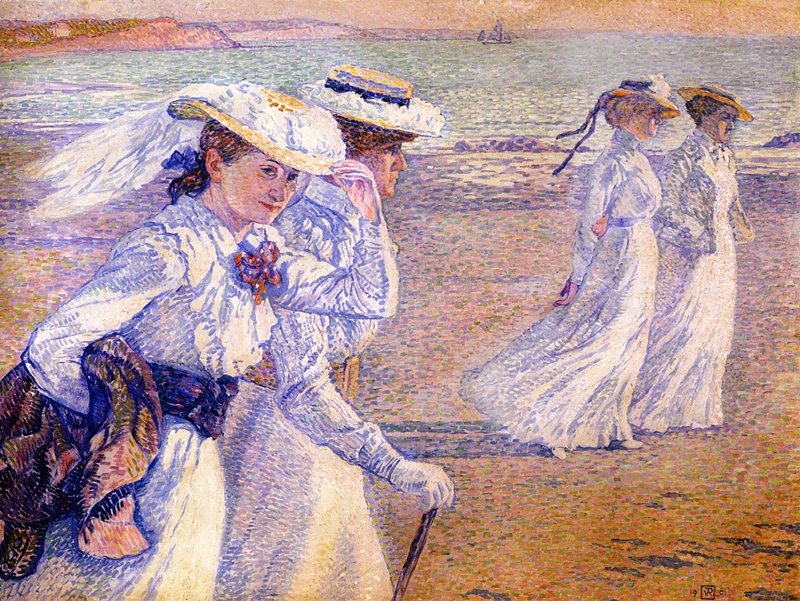Sergey Ivchenko [Сергей Ивченко] 1954-2008, Russian painter, was born in Frankfurt on the Oder, Germany. 1976 Graduated from Art Institute, Moscow, Russia. 1975-1991: worked in various art studios in the USSR. 1990: as a member of the group of artists took part in the action "Falling of the Berlin wall", Berlin, Germany. 1991 immigrated to Israel. 1992-1994 worked as a computer graphic artist, and then as an Art Director in the "Utopia" company, Haifa.

Sergey Ivchenko ~ Abstract Expressionist painter

La nascita di Venere, 1863 | Émile Zola contro Cabanel
Alexandre Cabanel (1823-1889), pittore francese, ottenne la grande fama nel 1863, con la Nascita di Venere, acquistata da Napoleone III nel 1863. Lo stesso anno, Cabanel venne nominato professore all'École des Beaux-Arts e membro dell'Académie des Beaux-Arts.
Cabanel, rigorosamente accademico nello stile, pittore di storia, di genere e ritrattista, fu nemico del Naturalismo e dell'Impressionismo, mentre fu attaccato dallo scrittore Émile Zola e da tutti coloro che difendevano la necessità di un'arte meno soave e più realista.

Monet: Ecco il mio atelier!
In una intervista, realizzata nell'aprile del 1880 da Emile Taboureux e pubblicata sul settimanale "Le Vie moderne" il 12 giugno 1880, al giornalista che gli chiedeva di mostrargli il suo studio, Claude Monet rispose:
- "Il mio atelier?
Ma non ho mai avuto un atelier, io, e non capisco come ci si possa chiudere in una stanza.
Per disegnare si, non certo per dipingere".
Quindi, in un gesto eloquente, puntato in direzione di Vétheuil e della Senna aggiunse:
- "Ecco il mio atelier!"
Pierre-Auguste Renoir | Monet nel suo giardino, 1873
.jpg)
Kees van Dongen | Fauve painter
Cornelis Theodorus Maria "Kees" van Dongen (1877-1968) was a Dutch-French painter, who was one of the leading Fauves.
He took evening classes in geometric drawing from 1892-1897 at the Akademie voor Beeldende Kunsten in Rotterdam.
In 1895 he began working intermittently for the newspaper Rotterdamsche Nieuwsblad, for which he made, among other things, a series of bright watercolour drawings of Rotterdam’s red-light district and illustrations of Queen Wilhelmina’s coronation.
.jpg)
Paul Cézanne, il pittore più pagato del 2012
Durante il 2012, Paul Cézanne 1839-1906, pittore post-impressionista francese, con il quadro "I giocatori di carte" 1890-1895, olio su tela, cm 47,5x57, è stato giudicato il pittore più pagato del mondo.
A febbraio, il quadro "I giocatori di carte" all'olio del pittore post impressionista, è stato comprato all'asta dalla famiglia reale del Qatar, mentre, il maggio scorso, un acquerello su carta, eseguito da Cézanne tra il 1892-1896 per lo studio preparatorio di 46 centimetri per 30 per il celebre capolavoro, è stato battuto all’asta da Christie’s a New York per 19,12 milioni di dollari - 14 milioni di euro.
A febbraio, il quadro "I giocatori di carte" all'olio del pittore post impressionista, è stato comprato all'asta dalla famiglia reale del Qatar, mentre, il maggio scorso, un acquerello su carta, eseguito da Cézanne tra il 1892-1896 per lo studio preparatorio di 46 centimetri per 30 per il celebre capolavoro, è stato battuto all’asta da Christie’s a New York per 19,12 milioni di dollari - 14 milioni di euro.
I giocatori di carte - Acquerello di Paul Cézanne
.jpg)
Yuqi Wang, 1958 | Portrait painter
Yuqi Wang / 王玉琦 was born in China, 1958. He now lives and works in Brooklyn, New York.
His work has been collected by many public institutions, including: the Smithsonian National Portrait Gallery in Washington D.C. , the Art Museum of Harvard University, China National Gallery, as well as by private collectors all over the world.
His work has been recognized with awards both nationally and internationally, winning the "Grand Prize" at The International Portrait Competition of the Portrait Society of America and "Second Prize" at The Portrait Competition of the Smithsonian National Portrait Gallery in Washington D.C., among others.

Théo Van Rysselberghe and the Neo-impressionism
Théo (Théophile) van Rysselberghe (1862-1926) discovered the pointillist technique when he saw Georges Seurat's La Grande Jatte at the eighth impressionist exhibition in Paris in 1886.
Together with Henry Van de Velde, Georges Lemmen, Xavier Mellery, Willy Schlobach and Alfred William Finch and Anna Boch he "imported" this style to Belgium.
Seurat was invited to the next salon of Les XX in Brussels in 1887.

Giovanni Dalessi, 1964
Giovanni Dalessi undeniably belongs to the upper segment of Dutch realism.
His meaningful works are loved by a large audience.
Because he is able to put his own personal stamp on time-honored themes such as portrait, still life and landscape, he distinguishes himself from his colleagues.
Giovanni takes the subjects of his paintings from his immediate environment.
Iscriviti a:
Post (Atom)
